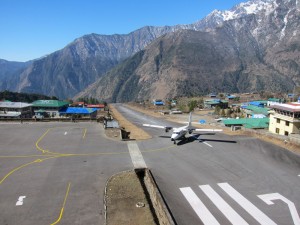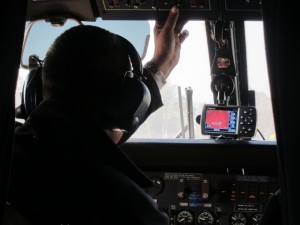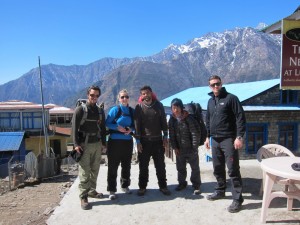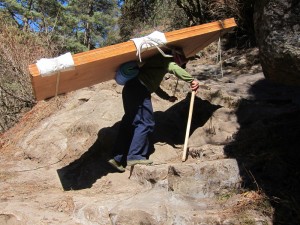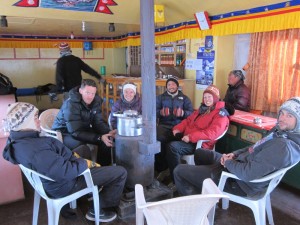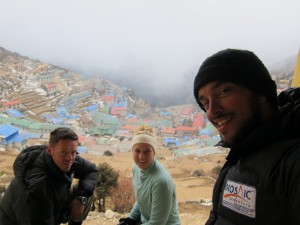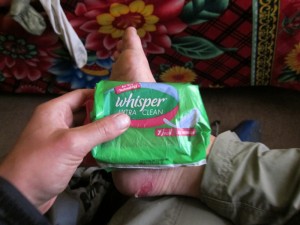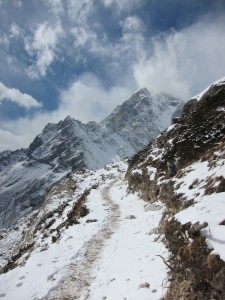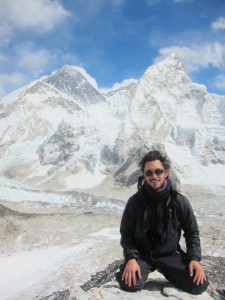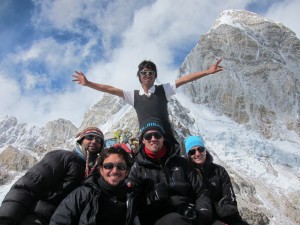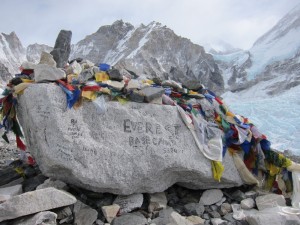Which hike to do in Nepal…Everest Base Camp or the Annapurna Circuit? After careful research and introspection, my ego won. Everest Base Camp is bigger, more challenging, and known for the better views. Once I arrived in Kathmandu, I was surprised at myself when I followed a nice young tout who approached me in the Thamel, Kathmandu’s tourist and trekking center, into the office of Mosaic Adventures. I talked about the possibilities with Raj, the always smiling manager, said I would compare costs and check back in with him the next day.
Click here for full photo album.
After reading reviews and comparing costs I was convinced this was a reputable company and a good deal. Raj wrote me to say a couple was planning on leaving the following day and I could join. The camaraderie of joining others appealed to me. My new trekking pals were a charming couple that lived in London, Daniel, a gregarious Paramedic from the UK, and Anine, a sweet determined Physical Therapist from Norway. They were both very welcoming of their new third wheel, or gooseberry as they say in the UK (not to be confused with dingle berry).
Flight to Lukla
Lukla is the gateway to Everest as it’s the main commercial airport to serve trekkers in the region. The airport is listed as one of the top ten most dangerous airports in the world. The runway is damn short. Only small planes can manage that length of airstrip. It’s built at an angle so planes land going up hill, and they decelerate quickly.
The planes need to turn quickly at the end of the 1500 foot long strip or they face a collision with the mountain wall. Flights are often delayed or cancelled due to fog and wind. At least one or two planes crash a year going into Lukla. I would find out later that our guide had lost a fellow friend who also was a guide last year in a crash.
At Kathmandu Airport we faced a four-hour delay due to weather. We were lucky though, as no flights had gone out the previous three days because of weather. We nervously boarded the 16-seater twin otter plane and were off. The views of the mountain ranges from the plane were incredible, except for the fact I was on the wrong side. The guy across the aisle’s head was obscuring the whole window. The plane jittered side to side or up or down with every gust. The pilot and the control panel were in plain view, as the cockpit didn’t have a door. I was close enough to decipher the GPS that indicated where the mountains were. We had to avoid the red masses on the screen. Eeeeek!
Arrival
Still shaky, but grateful, from the plane ride, we were greeted by Hari, our young handsome Nepalese guide. We scuttled a few meters away from the airport, took in the breathtaking mountain views and felt the chill in the air. We sat down for breakfast and Hari offered us a porter and introduced us to a quiet small teenager named Chering Sherpa. His last name is Sherpa, and while not all porters are Sherpas, Sherpas are the most famous of the porters. The Sherpa people migrated to the Himalayan Mountains a few generations ago exiled from Tibet. Once very poor, they now are one of Nepal’s most prosperous people due to the influx of trekking money to the region.
We debated over breakfast whether we should carry our own packs or have Chering carry them. He looked tiny, not more than 120 lbs, yet he offered to carry up to 80lbs worth of stuff. It would cost us $50 dollars each for the entire twelve to fourteen day trip. I had porters on Kilimanjaro and knew the luxury of carrying only the essentials when struggling up hill. I was relieved when they agreed. A day into the trek we were so glad we did it, and the decision only seemed wiser and wiser as we moved up.
And We’re Off!
The beginning of the trek featured gorgeous pines with snow covered mountains peaking behind. We romped over several suspension bridges covered in prayer flags over the Dudh Kosi River. Along the way we passed porters carrying supplies up the mountains. The amount they could carry on their backs via their head strap harness system is mind-boggling.
It hurts your neck just to think about it. Our first day was a short two-hour walk and we arrived at our first teahouse.
Along the route to basecamp teahouses are scattered along the route, so there is no need to camp. A teahouse is a restaurant / guesthouse combo, the main feature of which is a wood fire oven or a yak poop fire oven in the middle of the common room to provide heat and heat water. This is the only source of heat in the teahouse. They also provide rooms with firm beds and shared, often frozen, toilets.
On our second day we got our first view of Everest, it was just a small triangle jutting behind a couple better looking peaks including the sexy Ama Dablan. The second day was actually one of the hardest with a steep lengthy incline and weak untrained legs. We struggled getting up. That’s where I first started to notice Barry, but more about Barry later. There were other trekkers on the same route and we got to become friends with, even sharing the warmth of yak poop fires together. There were a couple young Aussies named Calvin and Nick, who should have their own misadventure travel show (Nick’s blog) a really nice couple from Calgary Amy and Kevin, and we occasionally bumped into the pair of Aussie medicals students Dana and Matt.
At the end of the second day we got to Namche, the last bit of real civilization. It was a city carved into the mountain steps, an amphitheater of buildings cascading down.
This was the last chance for supplies, cheap chocolate, reliable Internet and a hot shower. This was where at 11,290ft we first felt the altitude. I was out of it, and my thinking was slightly impaired. Simple math in my head wasn’t so simple anymore. Luckily, I knew how altitude affected me from Kilimanjaro and knew I would be fine in the morning.
After another day acclimatizing in Namche (hiking up to a higher altitude and sleeping back down low) we were off to the village of Tengoboche, which included another few hours of rough uphill switchbacks. Once we got to the teahouse on top we gazed upon a picturesque Buddhist monastery, and had out first taste of the Himalayan winter cold. It started to snow and the winds on this exposed hill tore though the windows of the teahouse that night. I couldn’t ignore Barry anymore.
Meet Barry the Blister
After the second day, Barry was my constant companion on the trip. He started out as dime size blister on the back of my heel, but then grew to envelope what seemed my entire right foot. Barry was big, irritable and rubbed me the wrong way. At first I tried to treat him with duct tape, but during the second day I had discovered the duct tape rubbed off and the blister had popped. I could deal with the pain. It wasn’t usually more than a three or four out of ten, but it would sometimes cause a slight limp.
For a couple of days Dan and Anine had bandages and tape, and they nursed my wound. They only had limited supplies though, and I had eight more days of hike. An open wound wasn’t going to heel until after this trek. In the next village we arrived in, Dingboche, there were no proper medical supplies available in the single mountain store. After shooting ideas around the yak poop teahouse fire, Calvin came up with an idea, “Why not sanitary pads? Sanitary is in the name.” Brilliant. Absorbent. Tough. Delicate. They became my bandage under duct tape for the remaining week of the trip. Barry didn’t go away, but he did stay fresh, and I stayed confident.
Moving Right Along
The scenery and weather changed as we progressed up towards base camp. We soon were above the tree line and the landscapes became more surreal, foreign and spectacular.
We watched snow fall in the afternoon and evenings and trekked on snow-covered paths. The first days were filled with plenty of warm sunshine, but more and more our days were cloudy. The higher we got the more intense the wind blew, as we were more exposed. Sleep got more and more difficult as the weather got colder, even down to 0 degrees Fahrenheit, and the air got thinner. One would lie in bed trying to sleep with an accelerated heart rate. Dan likened one night’s attempt at sleep as an eight-hour panic attack. Spirits started to dip as well as people were getting sick, cold to the bone and tired from so many days hiking.
The High Point – Kala Pattar
Every step burned in my quads and required a full inhalation of oxygen. At eighteen thousand feet, breathing was labored and difficult. My heart rate felt like it was maxing out while taking a few slow steps up and resting. Determination, my ipod and the view that grew more impressive every step kept me going. That morning we had walked from the gross and cold village of Lobuche to Gorek Shep, the highest teahouse station before Everest Base Camp. At Gorek Shep most trekkers either head for the goal, Everest Base Camp, or the view, Kala Pattar. The morning was cloudy and we were worried we weren’t going to get views after all these days of walking. However, when we got to Gorek Shep, it cleared and we made the gamble the weather would hold out for the views.
Kala Pattar is a small viewpoint that sits amongst a 360-degree view of the Himalayas, including an impressive view of Everest. Surrounding this thin rock are dizzying sheer drops on two sides, which prompted me, exhausted and oxygen deprived, to crawl on all fours at its apex. After our guide Hari made it, I was the first of the group. A lone Frenchman was sitting on top that had passed us earlier. We took victory photos of each other and each munched on the best Snickers ever.
Then Daniel and Anine made it up. It was a beautiful half hour full of smiles, relief, joy and the most amazing mountain-view we had ever witnessed. Pictures and video can do the grandeur justice nor capture the awe we felt. We did it bitches!
Everest Base Camp
After returning to Gorek Shep our group was exhausted, cold and ready to go down the mountain after eight hard days of trekking. Others trekkers we had been sharing meals with along the way had decided to go to base camp when we had decided on Kala Pattar. That afternoon we traded stories while warming up our exhausted bodies by the yak poop oven. Now we had the tough decision of whether or not to go to base camp in the morning. We had already been higher, and had seen better views, so what was the big deal? If we left earlier and started down the mountain we could stay at better accommodation further down, get out of high altitude quicker and be closer to a hot shower. Our friends said it was a five hour round trip hike, but basecamp itself during off season is little more than an etched rock covered in prayer flags.
After a friendly debate, we agreed that we wanted the right to say we had been to Everest Base Camp…no explanations, no white lies and if it wasn’t all that, then at least we earned the right to say that. Ugh. The next morning we woke up early to make the trek, in full thermals and winter gear. After a few hills we ascended to a thin ridge. From the ridge there were beautiful views of the ice and snow covered mountains to our west. We could hear and see avalanches in the distance. As we got closer to base camp we walked near the frozen river and some of the most beautiful and interesting ice formations I have ever seen. This alone was worth the trip. After about two hours we had made it. While it didn’t feel as special as Kala Pattar, it was special knowing that we were heading down after we took our pictures by this monumental landmark.
Coming Down
The way down was a quick three days. I even jogged for quick bits to keep up with Dan’s long legs. What surprised me the most was how new the terrain felt, even though it was an up and back route. I had suppressed the lengths of uphill out of my mind and was astounded at how much we had done. The first day down Dan was possessed, and we passed three lodging options in the interests of getting further down for more oxygen, better food and warmth. The first day down we started out for Everest base Camp at 7:30 am got back to Gorek Shep around 12:00pm. We then started down and got to our teahouse in Periche at 6:00 pm totally spent. We toasted with our friends over a Mt. Everest Whiskey. We all joked about racing to Namche the next day for showers before the water ran out as we hadn’t had one in a week. Once in Namche, I even broke my no meat rule on the mountain and had Spaghetti Bolognese after my glorious hot shower. I felt human again.
The next day I wasn’t so human anymore. I believe it was bad meat that had been sitting around, but others hadn’t been fazed. The last day was a tough six hour hike. I could not keep up with Dan and Anine. During lunch I felt totally spent. At lunch all of our groups decided to hike the last bit together, and I quickly fell behind. The sickness caught up with me and I was puking up lunch beside the trail with three hours left to hike. Hari caught up with me while I was puking. He stayed with me until the end while I suffered through sweating fits and pain from my blister. I walked back into Lukla limping and dazed, but I made it back relieved. After a tea I passed out.
I woke a few hours later to a whiskey party in our teahouse. It was 5:30pm and everyone was already getting tipsy. After a few bites of fried rice I managed a few sips of the Royal Stag, but was in no shape to down the amounts our party was celebrating with. A full on dance party ensued with our friends, guides and sherpas. It was joyous, festive and excessive. Whiskey was flowing freely, people fell over dancing and the same songs were played again and again from our guides’ phones via a speaker. All of us were happy to be off the mountain and hopefully going home the next day. We weren’t so lucky, however. We woke up at six am to get the early flight, but weather kept the airport quiet all day and we were stuck in Lukla until the next morning.
Everest Base Camp was an epic experience. I would recommend it to others who enjoy trekking, like the cold and are fit. Taking in the Himilayas from those heights feels like you’re on a different planet. The time we went, the end of the winter, was great. It was not too crowded on the mountain. That meant we had stunning views to ourselves, and intimate gatherings in the teahouses at night. It’s a walk back in time, as you get further away from civilization up the mountain. You have the opportunity to feel totally disconnected from the modern world, which is really relaxing, and is harder and harder to find in the increasingly wired world. It wasn’t easy trekking, but the struggle made the awe-inspiring views up top that much sweeter.

